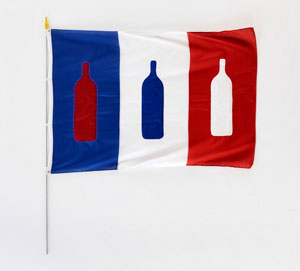7.19.24 — The Old Song and Dance
An American in Paris, the classic film, was not, as the saying goes, based on a true story. It does, though, come close to the stories of dozens of artists after World War II—the stories of “Americans in Paris,” at NYU’s Grey Art Museum through July 20.
William N. Copley was not the sort to break into dance like Gene Kelly as an aspiring artist in the movie, but he was plainly enjoying himself. He adds a distinctly American touch to the French flag, with the silhouette of a bottle on each color field in a further permutation of the good old red, white and blue. It suited a city in which a starving artist could afford dinner and drinks in cafés,  with or without Jean-Paul Sartre and Simone de Beauvoir. One could rent a hotel room on the cheap as well, although with water for that bottle down the hall or in a public shower. Copley did not yet have his familiar cartoon style, but he was already playing with outlines and stereotypes. And others, too, were taking in French art while leaving it behind.
with or without Jean-Paul Sartre and Simone de Beauvoir. One could rent a hotel room on the cheap as well, although with water for that bottle down the hall or in a public shower. Copley did not yet have his familiar cartoon style, but he was already playing with outlines and stereotypes. And others, too, were taking in French art while leaving it behind.
Artists might stay in Paris after the fighting, for who could leave the city altogether behind? Or they might return on the GI bill, which paid for studies abroad (and Fernand Léger himself was giving lessons). They might feel themselves in a tradition of Americans in Paris, like Mary Cassatt in pursuit of a singularly American Impressionism or Gertrude Stein and her circle, at the very heart of modern art. Where a year in Paris was once a demand on any artist, now it meant taking chances on yourself and whom you might become. Who needed music by George Gershwin when Americans were, increasingly, the stars. In truth, the “school of Paris” was past its prime in 1951, the year of the film, but “Americans in Paris” has ten more years to come, closer and closer to the postwar art you know.
The large show reverses the conventional picture. You may think first of Europeans fleeing to America for their careers, like Hans Hoffman, or their very lives, like Arshile Gorky. You may think of French art then as an increasingly watered-down Surrealism—the kind that Americans like Jackson Pollock back in New York had to outgrow. You may think of other Americans working their way through a dark prewar realism, like Adolph Gottlieb in still life or Mark Rothko in the subways. The Grey Museum has little other than abstraction, in coarse metal and painting. This could be Abstract Expressionism and then Minimalism by another name.
To be sure, Americans had a lot to learn. The show opens in the late 1940s with Kenneth Noland, with not a hint of his targets. He embeds cryptic symbols in black. Al Held has an almost uniform blackness, with thick, heavy brushstrokes far from the deep space of his wilder geometry. Nancy Spero paints darkly, too, and with an uncharacteristic tenderness—unless, that is, her Lovers is a rape scene. In no time, though, she is as confrontational as ever, with foul language in paint in French and English.
If they had a lot to learn, they had to learn it from each other or on their own. Many an artist heads to Paris for its museums, but quotations here are few and far between. The show does have a “salon” for what they might have seen in galleries and studios. It looks overly busy and largely irrelevant. Finer artists had at least an eye on the United States, where the action had begun. They lived in Paris, after all, not under a rock.
This could almost be a survey of postwar American art apart from Pop Art. Fluid colors in a shifting field of red, from Ed Clark, approach Gorky. Sam Francis and Claire Falkenstein leave plenty of room for brushwork on a field of white, like color-field painting for Noland or Joan Mitchell. Sure enough, Mitchell turns up as well. Others, too, had the germ of their art from the beginning, like comic-strip figures for Peter Saul, irony for William N. Copley, or a spare geometry for Carmen Herrera. Her red stripe across the bottom of a painting both anchors it and makes it pop.
They work big, and they push toward the edge of the canvas. William Klein, better known for urban photography, lends shadows to geometry, while thin white triangles cut across like arrows. Ellsworth Kelly spans more than one panel, although not yet shaped canvas. His curved green on white looks ahead to later work as well. By the show’s end, the school of Paris had few lessons left to give. It was not the first time that Europe had something to learn from visitors from the United States.
Read more, now in a feature-length article on this site.